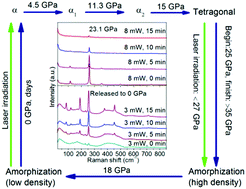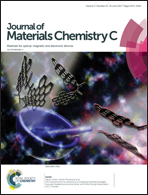Laser effects on phase transition for cubic Sb2O3 microcrystals under high pressure†
Abstract
The effects of laser irradiation and high pressure on the phase transition of cubic phase antimony trioxide microcrystals have been investigated. In situ Raman spectroscopy was performed at high pressure up to 45 GPa in a diamond anvil cell. The results indicated that two pressure-induced isostructural phase transitions occurred at 4.5 GPa and 11.3 GPa and were independent of laser irradiation. The Sb2O3 sample started transforming into a high density amorphous phase at 25 GPa and completed at more than 35 GPa. After irradiation for 7 minutes by 514.5 nm laser with 8 mW, the required pressure of the complete phase transition reduced to 27 GPa. On releasing pressure to ambient pressure, the samples reverse partly to the cubic phase, which takes days for the complete transition. This transition duration was reduced to seconds after irradiation by laser. It was also found that the residual amorphous phase at ambient pressure was of low density and medium-range order, which was not similar to the one that was observed at more than 25 GPa. The mechanism of laser irradiation boosting up the process of phase transitions was studied. Combining the cut-off wavelength of laser irradiation and absorption spectra, the photothermal effect induced via laser irradiation was found to dominate phase transition.



 Please wait while we load your content...
Please wait while we load your content...